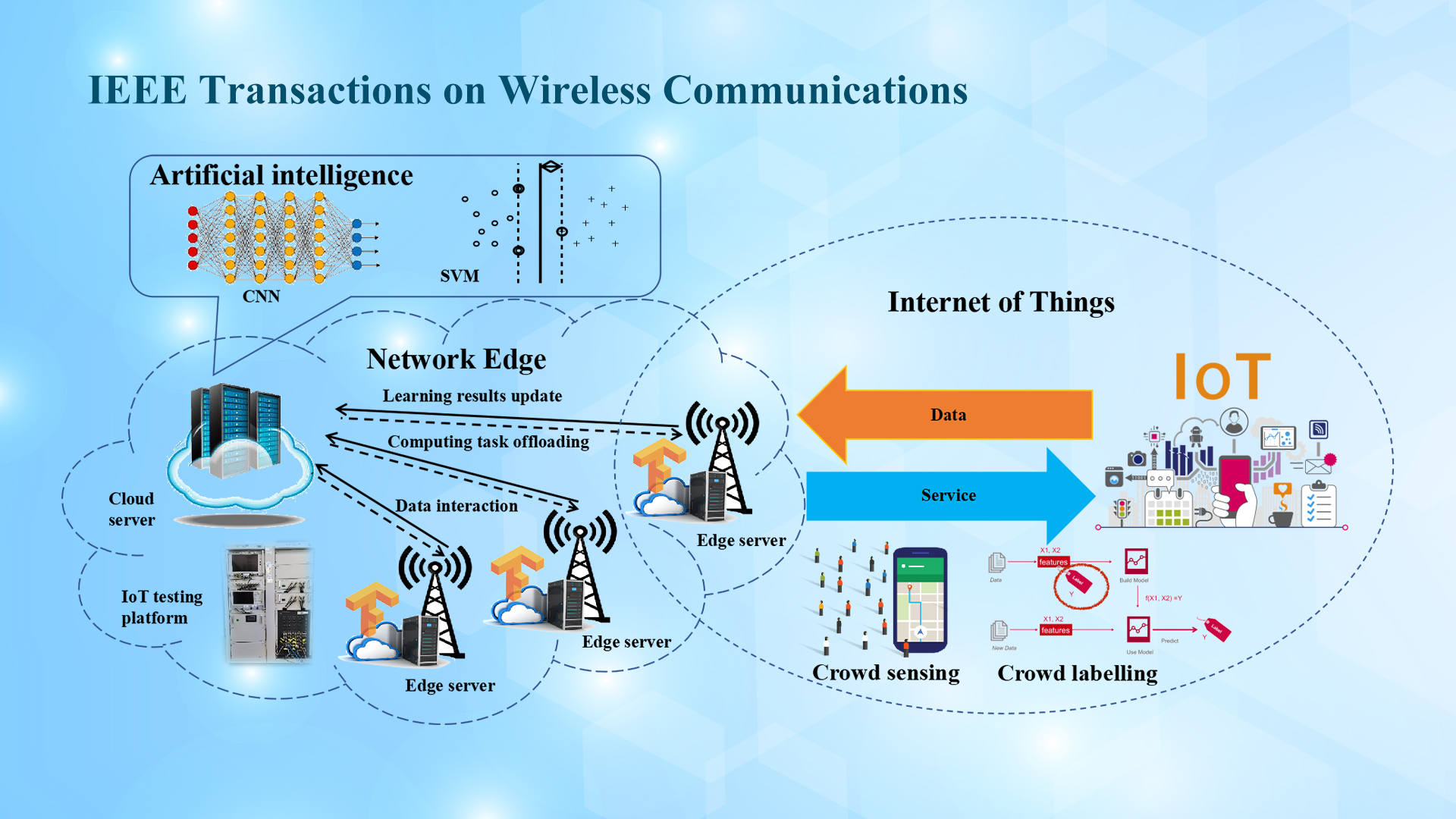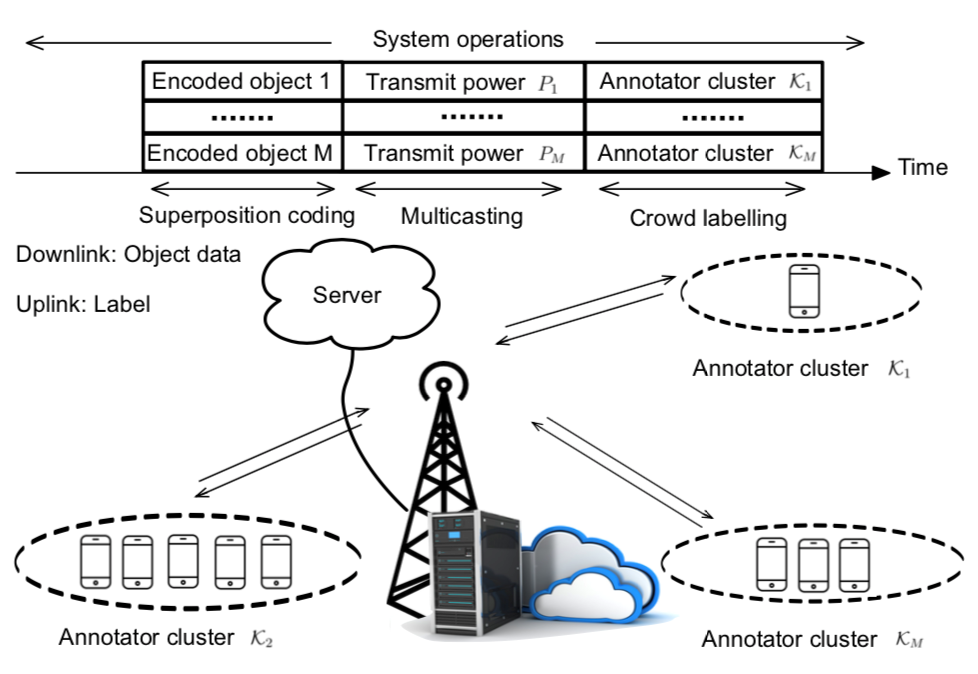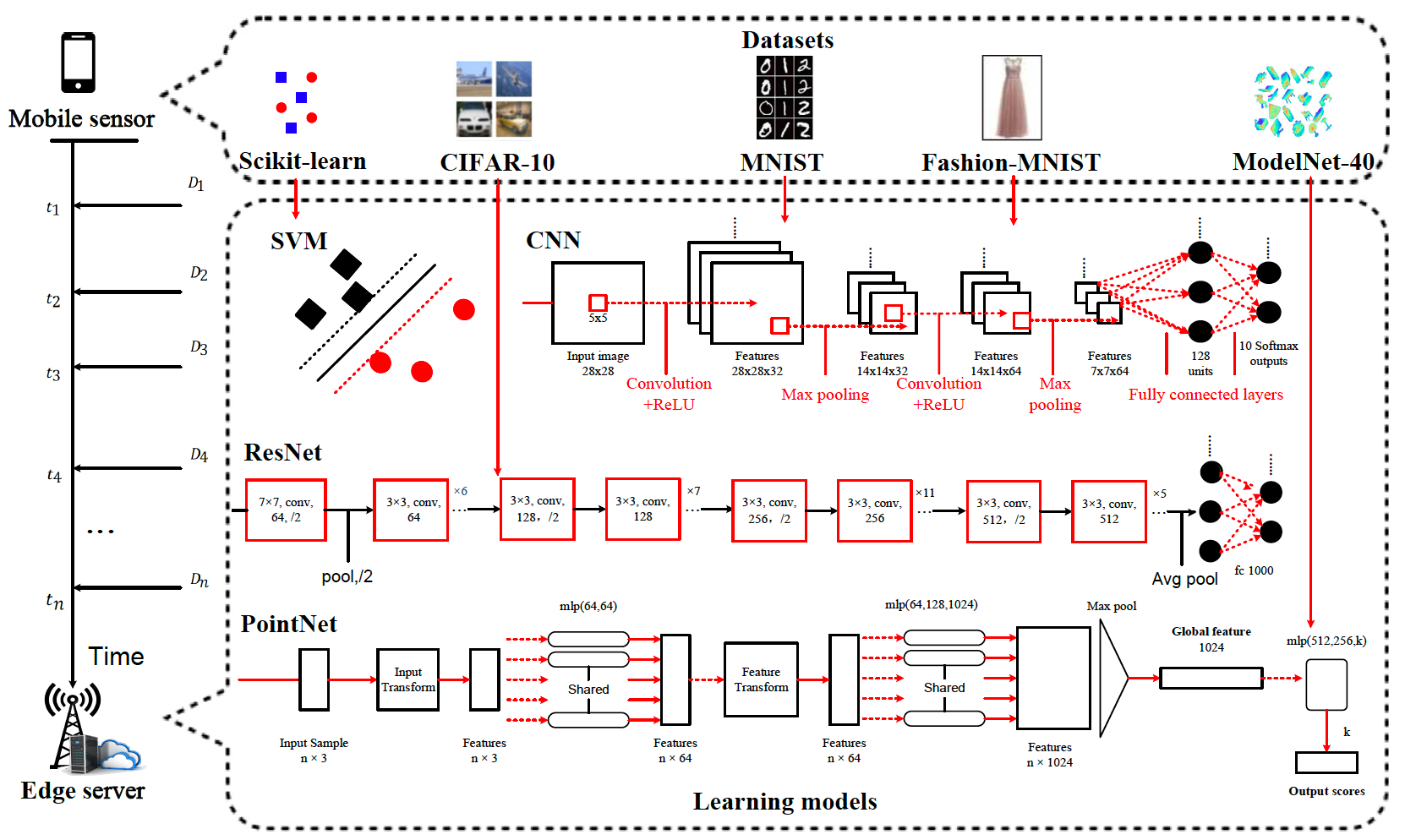Recent years have witnessed the revolutionary development of artificial intelligence in the Internet-of-Things (IoT) networks due to the strengthened computation capability of servers. The intelligent IoT applications have enabled a series of services such as auto-driving, smart homes, and public-safety surveillance. Nonetheless, these services generally require tremendous and different types of data, which need to be collected by the sensors and sent to the servers (Fig. 1).
In conventional wireless sensor networks, it is hard for a sensor to collect diverse types of data due to its limited sensing coverage and scalability. To overcome this bottleneck, crowd sensing has been proposed in recent years that leverages handheld and wearable IoT devices equipped with multiple sensing modules to collect different types of data. Moreover, labelling is an indispensable stage for guiding the intelligent model training process, especially in supervised and deep learning, which could be extremely laborious and costly. To deal with this problem, crowd labelling has been proposed by distributing the raw data to mobile annotators for labelling via wireless multicast channels.

Figure 1. Intelligent IoT networks
Professor Yi Gong’s research group from the Department of Electronic and Electrical Engineering (EEE) at the Southern University of Science and Technology (SUSTech) has recently made great progress in crowd sensing and crowd labelling for intelligent IoT networks. The research outputs have led to three papers published in IEEE Transactions on Wireless Communications (IEEE TWC), a top journal in the area of wireless communications.
The first paper published in IEEE TWC was entitled “Joint Sensing and Communication-Rate Control for Energy Efficient Mobile Crowd Sensing”. The previous works have simplified two design issues, namely joint control of sensing and transmission processes and corresponding energy consumption. Moreover, as the sensing module of devices might be occupied by other applications, there exists a busy time interval when the device is incapable of sensing.
To address the above issues, the sensing and transmission processes are jointly controlled to improve energy efficiency. It is found that the optimal sensing and transmission rates over time should follow the string-pulling structure given the amount of sensed data during the busy time. The string-pulling structure is to stretch a string as tight as possible in a tunnel, as shown in Fig. 2. The optimal amount of sensed data during the busy time can be further obtained by the segmented search.
Mr. Ziqin Zhou, a postgraduate student from the Department of EEE at SUSTech, is the first author of this paper. Prof. Yi Gong and the Presidential Distinguished Research Fellow Dr. Xiaoyang Li are the co-corresponding authors. Prof. Kaibin Huang from the University of Hong Kong (HKU) and Prof. Changsheng You from the Department of EEE at SUSTech are the co-authors. SUSTech is the first unit of this paper.

Figure 2. Joint sensing and transmission rates control for energy-efficient crowd sensing
The second paper was entitled “Energy Efficient Wireless Crowd Labelling: Joint Annotator Clustering and Power Control”. As for crowd labelling, passing large datasets with high-dimensional samples to mobile annotators results in a heavy communication burden and huge energy consumption. To alleviate the communication burden and reduce energy consumption, the power allocation and annotator clustering strategies are jointly designed, as shown in Fig. 3. It is found that the optimal annotator clustering must be sequential with the order of channel gains. Based on such a finding, the optimal power control and annotator clustering strategies can be found by tree search.
Dr. Xiaoyang Li is the first author of this paper. Prof. Yi Gong is the corresponding author. Dr. Guangxu Zhu from the Shenzhen Research Institute of Big Data (SRIBD), Prof. Kaiming Shen from the Chinese University of Hong Kong, Shenzhen (CUHK-Shenzhen), Prof. Kaibin Huang, and Mr. Ziqin Zhou are the co-authors. SUSTech is the first unit of this paper.

Figure 3. Joint annotator clustering and power control for energy-efficient crowd labelling
The third paper was entitled “Data Partition and Rate Control for Learning and Energy Efficient Edge Intelligence”. As for intelligent IoT networks, a server might have multiple learning models to be trained. The communication bottleneck between the data resource and the server results in deteriorated learning performance as well as tremendous energy consumption.
To tackle this challenge, the data partition and rate control are jointly designed to improve the learning accuracy and energy efficiency, as shown in Fig. 4. By exploiting the heterogenous relationships between the learning accuracy and the amount of data sample for training different models, the optimal data partition policy is derived based on the Lagrange method. The optimal transmission rate control is further obtained by the string-pulling algorithm. The design is also extended for scenarios with random data arrival and limited data buffer capacity.
Dr. Xiaoyang Li is the first author of this paper. Prof. Yi Gong is the corresponding author. Dr. Shuai Wang from the Shenzhen Institute of Advanced Technology (SIAT), Dr. Guangxu Zhu, Prof. Kaibin Huang, and Mr. Ziqin Zhou are the co-authors. SUSTech is the first unit of this paper.

Figure 4. Data partition and rate control for learning-and-energy efficient IoT networks
These research studies were supported by the National Key R&D Program of China, National Natural Science Foundation of China (NSFC), Guangdong Science and Technology Program, Shenzhen Science and Technology Program, Chinese Postdoctoral Science Foundation, University Key Laboratory of Advanced Wireless Communications of Guangdong Province, and the IoT Intelligent Information Processing Engineering Laboratory of Shenzhen.
Paper links (In order of appearance above):
1. https://ieeexplore.ieee.org/document/9892686
2. https://ieeexplore.ieee.org/document/9904506
3. https://ieeexplore.ieee.org/document/9775613
To read all stories about SUSTech science, subscribe to the monthly SUSTech Newsletter.
Proofread ByAdrian Cremin, Yingying XIA
Photo By